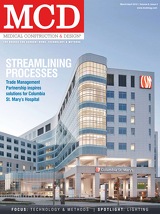Medical Construction & Design (MCD) is the industry's leading source for news and information and reaches all disciplines involved in the healthcare construction and design process. To view more past issues go to: http://mcdmag.epubxpress.com
Page 18 of 70
Green News
pathway for this hot return air to get back to the cooling units is an effective means of minimizing this mixing. Required is the extension of the return air opening on top of the computer room cooling units to the ceiling plenum and openings in the ceiling system above the hot aisles.
STEP 2: Consider air-side economizers Much like opening a window on a cool day, an air-side economizer takes advantage of cooler out- side air to cool the inside of your data center. At the very least, it requires much less energy than typical HVAC systems, and often provides free cooling. In the past, data centers avoided the use of air-side economizers because of a belief in the need to maintain tight humidity and temperature controls. However, companies such as Intel have proven servers are much more durable than previously believed. The best news: paybacks can be
enormous. A typical data center using an economizer could see as much as a 60- to 70-percent reduction in cooling bills compared to data centers without them.
STEP 3: Use water-cooled equipment An air-cooled DX unit or chiller uses about 1.2 kW per ton of cooling while a water-cooled chiller plant uses only 0.7 kW per ton. Therefore,
using water to cool refrigeration equipment represents a signifi cant savings. The advantages of using a water-cooled system include higher effi ciency, lower total power usage (frees up capacity to add more servers in the future), less noise and less space. Be sure to consider the water usage of a system, the cost of water and the impact of water use to the surrounding ecosystem. The reliability of the makeup water system is critical too, but can be solved with wells, storage tanks or redundant water sources. Healthcare institutions are under
tremendous fi nancial pressure. Building or upgrading a data center to use less energy can seem like a low-priority project. However, many states, electric utilities and the federal government are offering incentives, tax credits and rebate programs that help to relieve start-up costs pressure, as well as pay for many energy-effi cient systems and upgrades. Forward- thinking hospital IT departments are seeking and combining incentives along with proof of future energy (and fi nancial savings). The addition of fi nancing and incentives to a plan for energy reduction can help create a rock-solid business case for a low-energy data center.
As Principal of Mazzetti Nash Lipsey Burch, John Pappas has focused on the conception, design, implementation, testing and operation of mission-critical facilities for 20 years. He has pioneered the development of cooling systems for high-density data centers exceeding 200 W/sf.
14 Medical Construction & Design | March/April 2012
www.mcdmag.com
